

Outdoor Kitchen Installation in your backyard is critical for several reasons. It increases your living space by extending the interior outdoors, but it also expands your possibilities for entertainment by creating a distinct area for cooking, grilling, and dining. An outdoor kitchen eliminates the need for many excursions back and forth between the interior kitchen and the backyard, enabling you to cook and socialize simultaneously. Furthermore, outdoor kitchens’ culinary adaptability opens up a world of opportunities for experimenting with various cooking techniques and cuisines. Installing Custom Outdoor Cooking Station in Atlanta offers numerous health benefits from cooking to eating outside. It includes exposure to sunlight and the stress-relieving effects of nature, contribute to overall well-being.
At Outdoor Makeover and Living Spaces, our expert Outdoor Kitchen Builders near me in Atlanta design and build backyard kitchens in all types of masonry. Incorporating our outdoor living practices, we build kitchens that are functional and beautiful. Whether a grilling station or a gourmet cooking area, we will build Custom Outdoor Cooking Station in Atlanta to suit your lifestyle. When we do Outdoor Kitchen Installation, we are building an extension of one of the most important living spaces in your home. As a design-build company that provides all services outside, we can easily run water, electricity, and gas to any small or modern outdoor kitchen on the property. Our design team of Outdoor Kitchen Contractor in Atlanta can incorporate many kitchen elements as well. This includes outdoor grill station, smokers, outdoor sinks, refrigerators, and stovetop cooking surfaces. Backyard kitchens can have power and plumbing incorporated into them. Create a welcoming outdoor living space with seating and entertainment elements too!
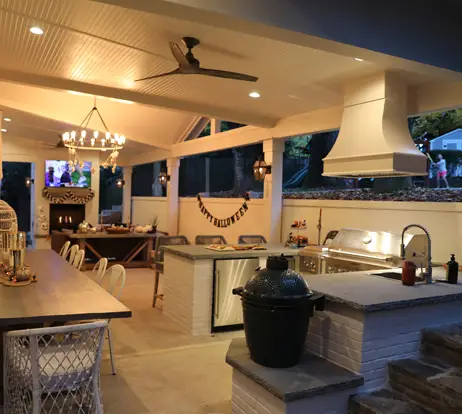
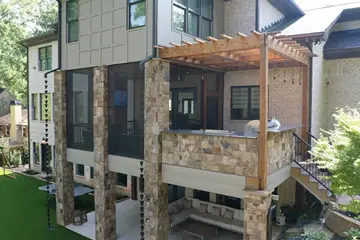
On Deck, outdoor kitchen installation in Atlanta refers to a kitchen that is specifically designed and installed on a deck usually right outside the kitchen. This type of outdoor kitchen provides a convenient and functional space for cooking and food preparation while enjoying the outdoors. By combining the natural beauty of the outdoors with the art of cooking, an Outdoor Kitchen on Deck creates an inviting atmosphere for entertaining guests, hosting gatherings, and savoring meals amidst the open air. This extension of the indoor kitchen not only adds value to the home but also offers a delightful escape to the joys of cooking and dining in the nature.
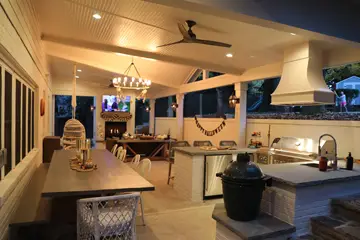
An on-ground Modular backyard Outdoor Kitchen design provides a wonderful and functional space for cooking, dining, and entertaining in the great outdoors. It features a variety of amenities, such as a durable cooking surface, a built-in grill or stove, ample counter space for food preparation, and a sink for convenient cleanup. Whether nestled within a lush backyard or by the poolside, this innovative concept brings the convenience of an indoor kitchen to the great outdoors. Moreover, it allow you to relish the joys of outdoor living without compromising on comfort or style.
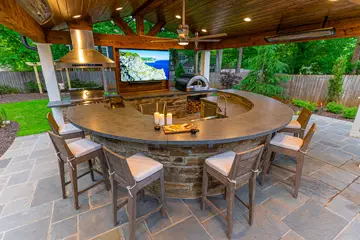
An Outdoor Kitchen Bar is a fantastic way to extend the functionality of the outdoor space, allowing guests to interact with the chef who typically is the homeowner that loves hosting friends and family gatherings in the backyard. Outdoor bar creates a designated area specifically for entertaining visitors, serving refreshments, and fostering a dynamic social environment. This one of the best outdoor kitchen designs not only enhances the enjoyment of outdoor parties but also adds an elegant touch to the overall aesthetics of the outdoor kitchen, blending both style and practicality seamlessly.

Concrete countertops are an excellent choice for outdoor kitchens, combining both functionality and aesthetics seamlessly. Their remarkable durability and ability to withstand varying weather conditions make them a reliable option that stands the test of time in outdoor settings. Concrete countertops add a sense of modern elegance to the outdoor cooking area. In addition to providing remarkable resilience to rain, sun, and temperature changes. These countertops improve the appearance of your outdoor kitchen while offering a stable surface for cooking and entertaining, whether you’re holding a summer barbeque or having a warm winter get-together.
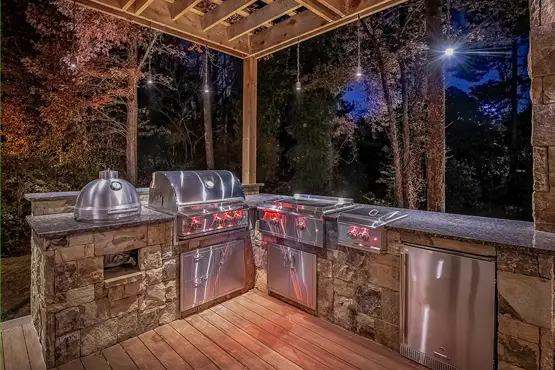
Granite countertops are a perfect choice for outdoor kitchens due to their durability, natural beauty, and resistance to weathering. They are an excellent choice for individuals looking for both flair and substance in their outdoor culinary spaces. Because of their exceptional longevity, innate natural beauty, and incredible resistance to the elements. Granite countertops not only provide a functional work surface but also contribute to the overall aesthetic appeal of the outdoor kitchen. From scorching sun to torrential rain, these countertops are designed to withstand the rigors of nature, ensuring your outdoor kitchen remains a hub of culinary delight for years to come.
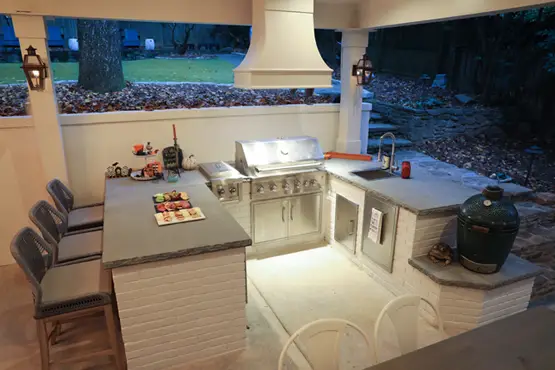
Penn Blue Stone countertops not only provide exceptional durability and style for outdoor kitchens. They also offer a touch of timeless elegance that seamlessly blends with various design aesthetics. The unique patterns and hues found in each slab of Penn Blue Stone add a sense of character to the outdoor cooking space. Plus, making it a focal point for gatherings and culinary creations. With its innate ability to withstand the harshest of weather conditions, these countertops continue to exude their charm while requiring minimal maintenance. Whether it’s a casual barbecue or a gourmet feast, Penn Blue Stone countertops set the stage for memorable experiences in the open air.
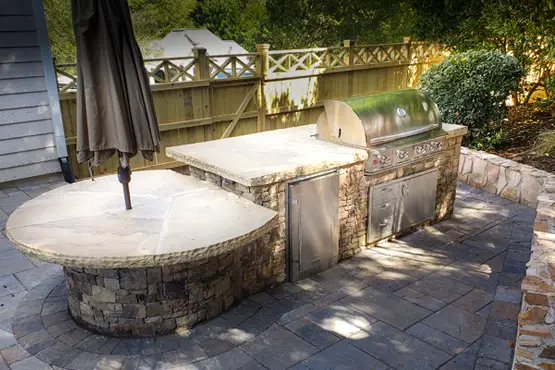
Specializing in crafting exquisite outdoor culinary spaces, Crab Orchard Countertops offers an exceptional array of stunning outdoor kitchen solutions that seamlessly marry rugged durability with timeless elegance. With their meticulously designed countertops, you have the opportunity to utterly metamorphose your outdoor living area, creating a haven where you can relish the beauty of nature while effortlessly hosting gatherings and events. Elevate your outdoor experience with Crab Orchard’s unparalleled craftsmanship and elevate your outdoor lifestyle to new heights of sophistication and comfort.
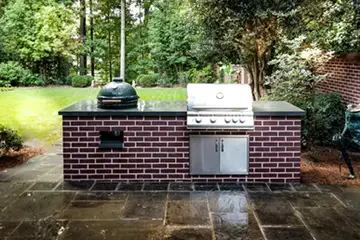
The Gas Grill is the perfect addition to your outdoor kitchen and also it comes in 3 and 4 burners. With its sleek design and powerful performance, it ensures a memorable grilling experience. The meticulously designed burners, engineered with precision, deliver a controlled and even heat distribution across the cooking surface.
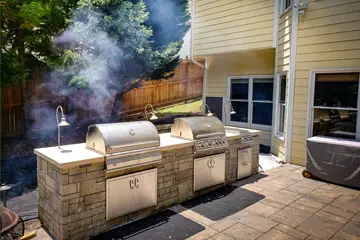
The Blaze charcoal grill’s components are precisely carved from 304 stainless steel, promising long-lasting reliability for your Outdoor BBQ Kitchen. It’s adjustable charcoal tray provides various temperatures across the cooking surface. With the Blaze charcoal grill, you’re not simply investing in an outdoor cooking appliance; you’re investing in the moments that will become cherished memories.

Gas pizza oven for outdoor kitchens provides convenience and quick cooking. It combines the traditional taste of pizza with modern functionality, making outdoor cooking a breeze. Its sleek design and practical features ensure that cooking outdoors is not just an occasional indulgence but an integral part of one’s lifestyle.
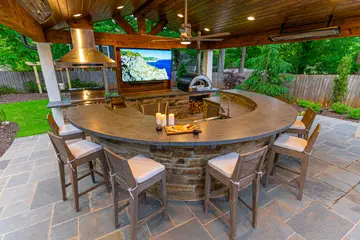
A traditional wood fired oven is made from bricks, clay, and stone. They are very heavy and they take a long time to construct. Although they are excellent at cooking pizza, they are not practical or affordable for most people. Perfect combination for cozy gatherings, delicious meals, and warm ambiance.
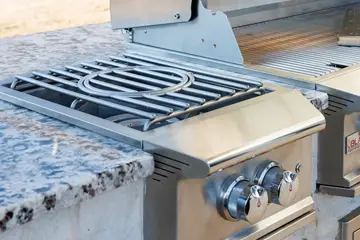
Experience outdoor culinary excellence with the Power Burner kitchen. The Power Burner outdoor kitchen features high heat output, durable construction, versatile cooking options, convenient controls, and a sleek design for outdoor cooking enthusiasts. Easy controls ensure convenience. Elevate outdoor cooking with this exceptional option.
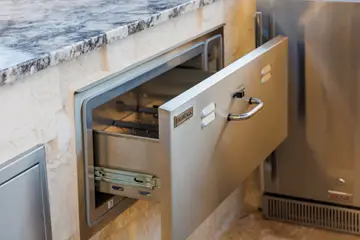
A warming drawer is a kitchen appliance designed to keep cooked food warm at a low temperature until it’s ready to be served. It’s often used to maintain the temperature of prepared dishes without overcooking or drying them out. Warming drawers are typically installed as part of a kitchen range or wall oven setup, and they can be a separate unit or integrated into the overall design of the kitchen.
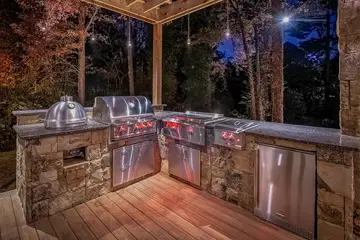
A kamado is a Japanese porcelain egg-shaped barbeque. Because of its adaptability, it is becoming increasingly popular among traditional barbecues. Due to its high heat retention, it is ideal for grilling, smoking, and baking delectable foods together or separately.
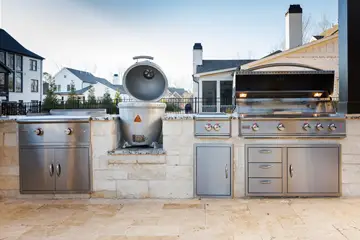
Made from heavy-duty cast iron that distributes heat evenly and retains heat for longer. Designed to maintain precise cooking temperatures during your busiest hours. Because of their size and shape, griddles can cook all of these foods at once.
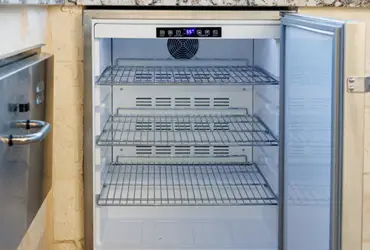
When selecting a refrigeration option for an outdoor kitchen, it is important to choose a unit specifically designed for outdoor use It is because to ensure durability and resistance to various weather conditions. Outdoor refrigerators, built with features like stainless steel construction and weatherproofing, offer ample storage for a variety of items. Beverage coolers are a suitable choice for those primarily in need of chilled drinks, while under-counter refrigerators are ideal for compact spaces. Outdoor ice makers provide a convenient source of ice, and chest freezers offer extra frozen storage capacity. By considering your specific needs and the available space, you can find the most suitable refrigeration option for your outdoor kitchen.

A sink improves the functionality, practicality, and usability of any outdoor kitchen setup. It serves as a convenient hand-washing station for cooks. It also eliminates the need for guests to enter the residence before or after meals to wash their hands. With a sink installed, meal preparation becomes a breeze, ensuring a smooth and mess-free cooking process. Enjoy the ease of a comprehensive outdoor culinary experience, where cleanliness and hygiene meet in harmony.
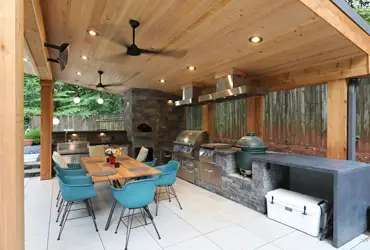
An outdoor kitchen hood, also called a barbecue hood, is a kitchen exhaust fan that is installed outside. It is most commonly in an enclosed or open patio. It offers stylish design, durable construction, versatile cooking options, and an immersive outdoor dining experience for any culinary enthusiast.
Are you looking for professional outdoor kitchen construction services? We’ve got you covered. At Outdoor Makeover and Living Spaces – #1 outdoor kitchen builders Near Me in Atlanta. With years of experience, our team of expert designers will help you come up with the perfect layout for your outdoor kitchen. We will discuss how you plan to use the outdoor kitchen space and make sure there is enough room for preparation, cooking, serving, and entertaining.
Make an appointment with our Outdoor Solution Designers today!
OR
Outdoor Makeover & Living Spaces is properly insured, has workman’s comp insurance, and holds a General Contractor’s license for decks, porches and roofs.
LET'S BE SOCIAL: